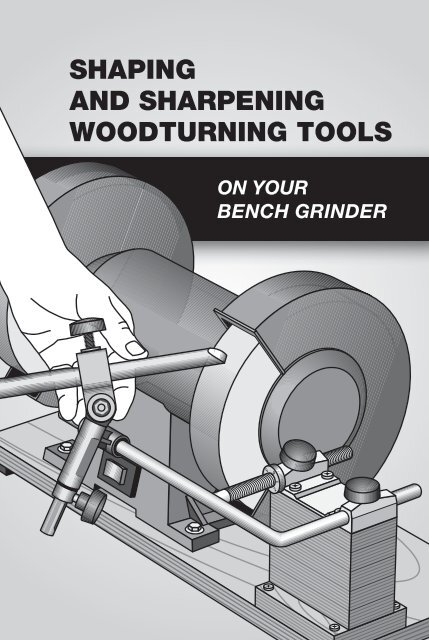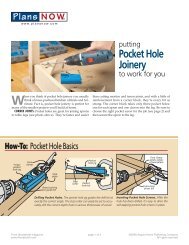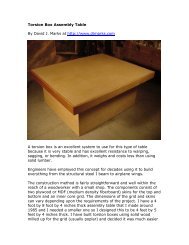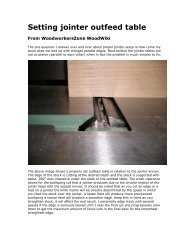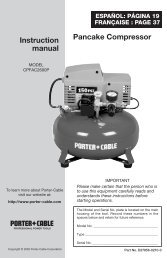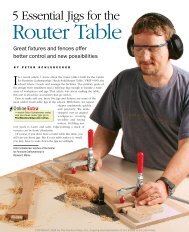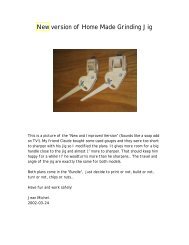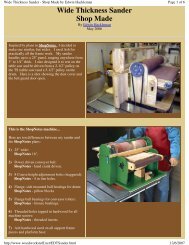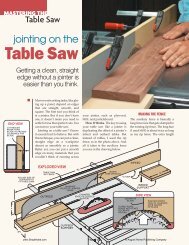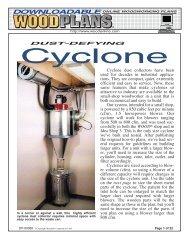shaping and sharpening woodturning tools - gerald@eberhardt.bz
shaping and sharpening woodturning tools - gerald@eberhardt.bz
shaping and sharpening woodturning tools - gerald@eberhardt.bz
You also want an ePaper? Increase the reach of your titles
YUMPU automatically turns print PDFs into web optimized ePapers that Google loves.
Shaping<br />
<strong>and</strong> Sharpening<br />
Woodturning Tools<br />
On Your<br />
Bench Grinder
© Tormek AB 2009<br />
All rights reserved.<br />
First edition.<br />
Tormek AB<br />
Box 152<br />
SE-711 23 Lindesberg<br />
Sweden<br />
9615-0906
The well tried Tormek jigs for the precision <strong>sharpening</strong> of turning <strong>tools</strong><br />
are now also suitable for your bench grinder. With the Bench Grinder<br />
Mounting Set BGM-100 you can use the Tormek purpose designed<br />
Jigs <strong>and</strong> the patented Turning Tool Setter TTS-100.<br />
These instructions are exclusively for HSS turning <strong>tools</strong>, since dry<br />
grinding at high speed is not suitable for ordinary carbon steel <strong>tools</strong><br />
due to the risk of overheating <strong>and</strong> its aggressive steel removal.<br />
The Tormek method makes a distinction between <strong>shaping</strong> <strong>and</strong> <strong>sharpening</strong>.<br />
Once you have created the desired shape on the tool, it is an<br />
easy task to re-sharpen the tool exactly to the same shape every time.<br />
After the <strong>shaping</strong> <strong>and</strong> <strong>sharpening</strong> you can go one or two steps further<br />
towards achieving the finest edge by finishing on a Tormek water<br />
cooled grinder. This is described in the h<strong>and</strong>book Sharpening Woodturning<br />
Tools the Tormek Way, which comes with the TNT-300<br />
Woodturner’s Instruction Box.<br />
The h<strong>and</strong>book Water Cooled Grinding <strong>and</strong> Sharpening of Edge Tools<br />
covers how to sharpen all your edge <strong>tools</strong> <strong>and</strong> the whole Tormek<br />
system.<br />
In the preparation of this h<strong>and</strong>book <strong>and</strong> the selection of the optimal<br />
shapes <strong>and</strong> edge angles, professional woodturners <strong>and</strong> <strong>woodturning</strong><br />
educational centres around the world have been of great help. I would<br />
like to thank all of you for your experienced advice.<br />
Torgny Jansson
Contents<br />
Mounting the BGM-100 Set on Your Bench Grinder.......................... 6<br />
About Bench Grinders........................................................................ 9<br />
Safety................................................................................................ 10<br />
Tormek Accessories for Your Bench Grinder.................................... 12<br />
Turning Tool Setter TTS-100............................................................. 13<br />
Gouge Jig SVD-185.......................................................................... 16<br />
Multi Jig SVS-50............................................................................... 18<br />
Tool Rest SDV-110............................................................................ 20<br />
Sharpening Bowl <strong>and</strong> Spindle Gouges............................................. 21<br />
Sharpening Exchangeable Cutters................................................... 27<br />
Sharpening Skew Chisels................................................................. 29<br />
Sharpening Roughing Gouges.......................................................... 32<br />
Sharpening Parting <strong>and</strong> Beading Tools............................................ 33<br />
Sharpening Scrapers........................................................................ 34<br />
Sharpening Thin <strong>and</strong> Flat Parting Tools............................................ 36<br />
Sharpening Elliptical Spindle Tools................................................... 36
Mounting the BGM-100 Set on Your Grinder<br />
The Bench Grinder Mounting Set BGM-100 can be mounted on grinders with wheel<br />
diameters from 150 mm (6") to 250 mm (10"). You mount the grinder on a self made<br />
wooden platform with a block for the Universal Support.<br />
You can build the platform for mounting the BGM-100 set on the left or on the right side<br />
of the grinder whichever suits you best. On some grinders you need to remove the tool<br />
rest, which comes with the machine in order to mount the Tormek Universal Support.<br />
You can also build the platform for mounting a set on both sides, which gives you<br />
a versatile <strong>sharpening</strong> station. For the second wheel you can mount the Tool Rest<br />
SVD-110. Thanks to the instant mountability of the Tool Rest you can quickly exchange<br />
it for the Gouge Jig SVD-185 or for the Multi Jig SVS-50.<br />
Left side mount<br />
Right side mount<br />
Mount on both sides<br />
6
Content of the Bench Grinder Mounting Set BGM-100<br />
• Universal Support with Micro Adjust 1pc<br />
• Base for the Universal Support<br />
1 pc<br />
• Rubber feet<br />
4 pcs<br />
• Mounting screws with washers<br />
8 pcs<br />
• BG-10 H<strong>and</strong>book<br />
1 pc<br />
• Profile Labels<br />
1 set<br />
Making the platform<br />
Use wood or plywood with a thickness of 20 mm or ¾". Build the block by gluing wood,<br />
plywood or hard board together to the recommended height. The dimensions depend<br />
upon your grinder, see sketches below.<br />
Length of platform<br />
This depends on your grinder <strong>and</strong> if you use<br />
one or two sets. The recommended lengths<br />
on the left <strong>and</strong> on the right side differ due to<br />
the asymmetrical Gouge Jig SVD-185.<br />
Depth of platform<br />
Use approx 200 mm (8") for 6" <strong>and</strong> 8"<br />
grinders <strong>and</strong> 250 mm (10") for a 10" grinder.<br />
Height of block<br />
Grinder size Distance to centre, S<br />
150 mm (6") 64 mm (2½")<br />
200 mm (8") 51 mm (2")<br />
250 mm (10") 51 mm (2")<br />
7
Drill 5 mm (3/16") holes in the block.<br />
Screw to the platform without pilot holes.<br />
Screw base to block without pilot holes.<br />
Mount the grinder with suitable bolts,<br />
which fit the holes in the grinder. Use<br />
washers under the bolt heads <strong>and</strong> nuts.<br />
Mount the rubber feet, which come<br />
with the set <strong>and</strong> you will get a steady<br />
platform with less vibration.<br />
8
About Bench Grinders<br />
Using the right type of grinding wheel<br />
Not all grinding wheels are suitable for the precision <strong>sharpening</strong> of edge <strong>tools</strong>. The<br />
st<strong>and</strong>ard wheels mounted on the grinder are often too hard <strong>and</strong> become glazed easily,<br />
which reduces steel removal <strong>and</strong> causes overheating of the tool. Use an aluminium<br />
oxide wheel with the right binding – not too hard to avoid glazing <strong>and</strong> not too soft to<br />
avoid grooves.<br />
Wheel surface<br />
The wheel surface must be kept fresh <strong>and</strong> clean. Worn grains must wear away so that<br />
new ones come into play. If not, the surface becomes glazed <strong>and</strong> the grains will rub<br />
instead of cutting, which will increase the friction <strong>and</strong> heat development. Use a diamond<br />
wheel dresser to maintain the surface in a good shape <strong>and</strong> condition.<br />
Influence of heat on HSS steel<br />
HSS steel can st<strong>and</strong> a much higher temperature than carbon steel without decreasing<br />
the hardness. However, at the very tip of the edge, which is very thin, the temperature<br />
can easily rise to a level which will affect the hardness. Therefore grind cautiously at<br />
the tip of the edge <strong>and</strong> do not allow it to become blue. Overheating HSS steel can<br />
cause a decrease in the hardness by as much as 4 HRC, which shortens the life of the<br />
edge. If you cool it in water, do not cool abruptly from a high temperature, since this<br />
can cause micro cracks invisible to the naked eye.<br />
Grinding dust<br />
The fine dust from the grinding wheel <strong>and</strong> steel particles from the tool can be a health<br />
hazard. It is best to use a dust extraction system, so the dust does not pollute the air.<br />
You must use a separate extraction system <strong>and</strong> not the same system as for your wood<br />
dust, since a spark could light a fire in the inflammable fine dust.<br />
9
Safety<br />
A bench grinder can be dangerous if not h<strong>and</strong>led with knowledge <strong>and</strong> respect. Follow the<br />
safety instructions, which come with your machine. Pay special attention to the following<br />
operational advice.<br />
• Wear eye protection.<br />
• Do not work near dry shavings or wood dust, since a spark can<br />
light a fire.<br />
• Secure the platform on your bench to ensure that the grinder<br />
does not move during operation. Use screws or a clamp.<br />
• Use only the Tormek accessories shown in this presentation<br />
on your bench grinder. Follow this instruction manual.<br />
• Check that all setting screws <strong>and</strong> knobs are properly tightened<br />
before commencing work.<br />
• Do not hold your h<strong>and</strong> or fingers close to the wheel to avoid<br />
the risk that they might slip <strong>and</strong> touch the wheel.<br />
• Do not press the tool harder against the wheel than that which<br />
enables you to keep full control of the grinding operation.<br />
• Always keep a part of the tool on the wheel during grinding<br />
<strong>and</strong> never let it slip wholly outside the wheel.<br />
Using the Multi Jig SVS-50<br />
Always let the jig rest on the Universal Support steadily before you carefully lower the tip of<br />
the tool to touch the wheel. Maintain pressure all the time towards the Universal Support.<br />
10
Using the Tool Rest SVD-110<br />
The platform must always be mounted so the surface points to or above the centre of the<br />
wheel. The distance between the platform <strong>and</strong> the wheel must not exceed 2 mm (3/32").<br />
<br />
Using the Universal Support as tool rest<br />
The distance between the Universal Support <strong>and</strong> the wheel must not exceed 2 mm (3/32").<br />
11
Tormek Accessories for Your Bench Grinder<br />
Turning Tool Setter TTS-100<br />
For setting the Gouge Jig SVD-185<br />
<strong>and</strong> the Multi Jig SVS-50.<br />
Gouge Jig SVD-185<br />
Bowl gouges <strong>and</strong> spindle gouges.<br />
Cutter/scraper tips.<br />
Multi Jig SVS-50<br />
Skews with a straight or curved edge.<br />
Roughing gouges, beading <strong>tools</strong> <strong>and</strong><br />
diamond section parting <strong>tools</strong>.<br />
Tool Rest SVD-110<br />
Scrapers, hollowing <strong>tools</strong>, large<br />
cutters. Thin <strong>and</strong> flat parting <strong>tools</strong>.<br />
12
Turning Tool Setter TTS-100<br />
No matter which grinding machine you use, the most difficult part in <strong>sharpening</strong> <strong>woodturning</strong><br />
<strong>tools</strong> is to replicate the shape <strong>and</strong> the edge angle. Tormek have solved this<br />
problem by developing a key to instant <strong>and</strong> exact <strong>sharpening</strong> – the Turning Tool Setter.<br />
This setting device takes the guesswork out of <strong>sharpening</strong>. There is no longer any<br />
need for trial <strong>and</strong> error to get the best edge shape for each turning operation. You just<br />
set the jig <strong>and</strong> get the shape you have selected. Thanks to the patented design it works<br />
irrespectively of the stone diameter. You can go from a 150 mm (6”) wheel to a 250 mm<br />
(10”) grindstone <strong>and</strong> achieve the same shape. The Setter is designed to work in conjunction<br />
with the Gouge Jig SVD-185 <strong>and</strong> the Multi Jig SVS-50.<br />
What determines the shape<br />
Three factors determine the shape of a gouge or a skew. By repeating them at each<br />
<strong>shaping</strong> or <strong>sharpening</strong> you will get an exact replication of the shape every time.<br />
Jig setting = JS Protrusion = P DISTANCE TO STONE<br />
13
Selected shapes <strong>and</strong> edge angles<br />
There are quite a few manufacturers of turning <strong>tools</strong> <strong>and</strong> the shapes <strong>and</strong> edge angles<br />
vary considerably. For example there are factory made skew chisels with skew angles<br />
from 15° to 30° <strong>and</strong> the edge angles vary from 25° to 40°. Factory made bowl gouges<br />
have edge angles from 30° to 60°. The wide range of shapes is the reason why Tormek<br />
up until now, has not made recommendations for setting the shape <strong>and</strong> edge angle.<br />
In the past, we have offered the technique <strong>and</strong> left each turner to find his or her own<br />
geometry.<br />
However, after having been in contact with many turners around the world, we now see<br />
the need for an aid to the quick setting of the jig <strong>and</strong> also for advice about some suitable<br />
shapes <strong>and</strong> edge angles. This newly developed Tormek Turning Tool Setter offers<br />
both. The geometries, i.e. the shape <strong>and</strong> edge angle have been selected after consulting<br />
experienced turners <strong>and</strong> should satisfy most needs.<br />
Which shape should I use<br />
The Turning Tool Setter is delivered with a Selection Chart where you can see which<br />
shape is suitable for your current type of turning. These geometries are recommended<br />
by experienced woodturners <strong>and</strong> recognized <strong>woodturning</strong> training workshops around<br />
the world, e.g. Craft Supplies in the USA <strong>and</strong> Drechselstube Neckarsteinach in Germany.<br />
Of course you can also sharpen with geometries other than the shapes provided by the<br />
TTS-100 Setter. If you have an existing edge geometry you can use the Marker Method<br />
or the Spacer Block Method for setting the edge angle at the re-<strong>sharpening</strong> (see p. 26).<br />
Shaping <strong>and</strong> <strong>sharpening</strong><br />
The Tormek method makes a distinction between the <strong>shaping</strong> <strong>and</strong> <strong>sharpening</strong> (or re<strong>sharpening</strong>)<br />
of a tool. When <strong>shaping</strong> you remove steel to achieve the shape <strong>and</strong> edge<br />
angle you want. When <strong>sharpening</strong> you just touch up an existing shape to renew the<br />
sharpness.<br />
If you have a Tormek machine, you can create the initial shape on your bench grinder <strong>and</strong><br />
finish the <strong>sharpening</strong> on your Tormek water cooled grindstone. You get the best of two<br />
worlds; the fast steel removal from your high speed bench grinder <strong>and</strong> the fine surface<br />
from your fine water cooled grindstone <strong>and</strong> the leather honing wheel. A finer edge gives<br />
the wood a smoother finish with less need for s<strong>and</strong>ing. A finer edge also stays sharp<br />
longer than a rough edge.<br />
Since the patented Turning Tool Setter TTS-100 works on all stone diameters, the shape<br />
<strong>and</strong> edge angles are exactly replicated even when you go from a smaller bench grinder<br />
wheel to the large Tormek grindstone.<br />
14
Metal contact discs<br />
Outer hole<br />
Inner hole<br />
There are two holes for locating the TTS-100 on the Universal Support.<br />
The type of tool decides which hole you use.<br />
Storage Magnet<br />
P=75 mm<br />
30°<br />
Patent pending<br />
P=65 mm<br />
45° 55°<br />
P=55 mm<br />
Edge angle measuring grooves<br />
Storage<br />
Magnet<br />
This side has stops for the recommended protrusions of the tool in the jig (P).<br />
15
Gouge Jig SVD-185<br />
The jig works on the Universal Support. The edge angle is set by moving the support<br />
back <strong>and</strong> forth. The Micro Adjust facilitates a precise setting.<br />
The tool holder can be set in<br />
any position from 0 to 6 <strong>and</strong><br />
locks with the Allen key (9)<br />
Parts<br />
The jig comprises a tool holder (1) which runs in a sleeve ( 2 ). The tool is aligned with<br />
a disc (4 ) <strong>and</strong> tightened with a knob screw (5 ). There is a washer ( 6 ) for wide gouges.<br />
The stop ring ( 7 ) can be set for a convex bevel with a screw ( 8 ). The setting can be<br />
noted on a special profile label (10 ), which is attached to the ferrule. A special pen which<br />
works on these labels, is included (11). For cutter/scraper tips there is a shaft (12 ) with a<br />
mounting screw (13 ) <strong>and</strong> a 2,5 mm allen key (14 ).<br />
16
a b a a c<br />
The special locking disc fits any size of tool, which is automatically aligned in the same position<br />
every time it is mounted. The disc can be positioned either along ( a ) or across ( b ) the tool.<br />
For wide gouges there is a removable washer, which fits on the disc ( c ).<br />
The disc also works if placed diagonally.<br />
Section seen from above.<br />
For a large gouge with a short flute the locking disc is<br />
removed. Grind a flat surface for repeatable alignment.<br />
17
Multi Jig SVS-50<br />
The jig works on the Universal Support. The edge angle is set by moving the support<br />
back <strong>and</strong> forth. The Micro Adjust facilitates a precise setting.<br />
The seat can be set<br />
straight or to any skew<br />
angle up to 45°.<br />
Parts<br />
This patented jig consists of a housing ( 1 ) <strong>and</strong> two interchangeable seats – one closed,<br />
( 2 ) <strong>and</strong> one open, ( 3 ). The seats can swivel <strong>and</strong> be locked with the screw ( 6 ) at any skew<br />
angle between 0° <strong>and</strong> 45°. Skew chisels should have symmetrical bevels on both sides.<br />
With this jig you mount the tool only once for grinding both the bevels. By turning the jig<br />
upside down you can grind both of the bevels symmetrically.<br />
18
Closed seat<br />
The closed seat has been developed for the precision <strong>sharpening</strong> of turning skew chisels<br />
with an oval or square section <strong>and</strong> with curved or straight edges. Since the chisel is mounted<br />
in the centre of the seat, the bevels are ground to exactly the same shape. The turning<br />
skew chisel is mounted with a side screw ( 4 ). Tool size 13 mm ( ½" ) to 35 mm ( 13/8" ).<br />
The closed seat is for skew<br />
chisels. The tool is fixed with the<br />
side screw ( 4 ). The top screw ( 5 )<br />
is not used.<br />
Open seat<br />
The open seat, where the tool is fixed with a top screw ( 5 ), is used for <strong>tools</strong> which have<br />
the edge ground square across the shank, such as parting <strong>tools</strong> with a diamond section,<br />
roughing gouges <strong>and</strong> bedan <strong>tools</strong>. Both seats are mounted with a bottom screw ( 6 ),<br />
which also locks the chosen skew angle. A scale on each seat shows the skew angle.<br />
The open seat is designed for <strong>tools</strong> which have the edge square across<br />
the shank. The tool is fixed with the top screw in the housing (5). As the<br />
seat can be turned, it can also be used for short skew chisels.<br />
19
Tool Rest SVD-110<br />
The Tool Rest works on the Universal Support. The edge angle is set by rotating the Tool<br />
Rest on the support. It has a generous surface, 90×110 mm ( 3½"×4¼" ), which permits a<br />
safe <strong>and</strong> steady positioning of the tool towards the stone.<br />
The bore is made with a special wedge shape, which increases the locking force by as<br />
much as 250 %. You can lock the Tool Rest instantly at the chosen angle. This unique<br />
design is patented by Tormek.<br />
With the patented design, only the<br />
sides of the tapered bore touch<br />
the round bar – not the bottom.<br />
This means that the locking action<br />
increases by as much as 250 %!<br />
20
Sharpening Bowl <strong>and</strong> Spindle Gouges<br />
These are ground with the Gouge Jig SVD-185. Bowl <strong>and</strong> spindle gouges can have an<br />
unlimited number of shapes. The variables are the edge angle (α) <strong>and</strong> the lengths of the<br />
wings (l). The third factor is how the wings are shaped. They can be straight or convex.<br />
Edge angle Length of wings Shapes of the wings<br />
Bowl gouges<br />
1 α=45°<br />
2 α=45°<br />
3 α=40°<br />
4 α=55°<br />
5 α=60°<br />
Spindle gouges<br />
1 α=30°<br />
2 α=45°<br />
JS 2<br />
P 65<br />
Hole A<br />
JS 2<br />
P 75<br />
Hole A<br />
JS 4<br />
P 65<br />
Hole A<br />
JS 6<br />
P 75<br />
Hole A<br />
JS 2<br />
P 55<br />
Hole B<br />
JS 2<br />
P 65<br />
Hole A<br />
St<strong>and</strong>ard profi le.<br />
Only lightly swept back wings.<br />
For turners of all skill levels.<br />
Irish profi le. Swept back wings.<br />
Swing the tool 180° from side<br />
to side.<br />
With long swept back wings.<br />
Somewhat aggressive.<br />
For professional level turners.<br />
The larger edge angle is benefi cial<br />
when turning deep bowls.<br />
“Ellsworth” shape.<br />
Wings are pronounced convex.<br />
For tight spots, detail work <strong>and</strong><br />
fi nest fi nish.<br />
For professional level turners.<br />
St<strong>and</strong>ard profi le.<br />
For turners of all skill levels.<br />
Skews The chart above shows suitable shapes, which have been recommended by experienced<br />
woodturners <strong>and</strong> recognized <strong>woodturning</strong> workshops, e.g. Crafts Supply USA <strong>and</strong><br />
Straight edges<br />
Drechselstube Neckarsteinach in Germany. JS 20° For tight spots, detail work <strong>and</strong><br />
1<br />
P 65 fi nest fi nish.<br />
α=30°<br />
Flat<br />
Oval Hole B For professional level turners.<br />
Decide which geometry you want. Once you have created the desired shape for<br />
Straight edges<br />
the tool, it is an easy task to re-sharpen JS it 20° to exactly For broad the application. same shape every time.<br />
2<br />
P 55 Easier to control than<br />
α=45°<br />
Flat<br />
Oval Hole B a 30° edge angle.<br />
3<br />
Radius edges<br />
α=30°<br />
Flat<br />
Oval<br />
JS 30°<br />
P 75<br />
Hole B<br />
For tight spots, detail work <strong>and</strong><br />
fi nest fi nish.<br />
For professional level turners.<br />
21
Shaping<br />
Set the Jig, JS.<br />
Mount the tool with the<br />
protrusion P.<br />
Set the Universal Support.<br />
Select hole A or B.<br />
Select a shape from the selection chart <strong>and</strong> make the three settings which will give you<br />
that shape. Grind with a light pressure so that you do not overheat the steel. Use the<br />
whole width of the wheel to minimize grooving <strong>and</strong> to prolong the wheel life. Check your<br />
grinding frequently to ensure that the gouge is ground evenly <strong>and</strong> acquires the shape<br />
you want. Grind more on the spots where needed. If you need to change the profile<br />
considerably, grind one side at a time. This is easier than continuously swinging the tool<br />
back <strong>and</strong> forth 180 degrees from left to right, <strong>and</strong> which could cause you to overgrind<br />
the centre of the edge.<br />
Shape one side at a time <strong>and</strong> use the whole width of the wheel. Finish with a full swing over the<br />
entire bevel.<br />
Note: Stick to the shape you have selected <strong>and</strong> do not switch from one<br />
shape to another. Then you will get the full benefit of the Tormek TTS-100<br />
Setter, since you can instantly replicate exactly the same shape every time.<br />
Should you need a different shape, we suggest that you buy another tool<br />
<strong>and</strong> grind it to your alternative shape. This way of working will give you<br />
more time for turning <strong>and</strong> fewer interruptions for <strong>shaping</strong> <strong>and</strong> <strong>sharpening</strong>.<br />
Shape <strong>and</strong> length of the wings<br />
The three settings do not automatically give you the shape you have selected. Your h<strong>and</strong>s<br />
<strong>and</strong> eyes decide the final shape within the limits of the settings. You can acquire different<br />
lengths on the wings by altering the width of your swing from side to side. A common<br />
problem is that the tip can be too pronounced. This is caused by grinding too much on<br />
the wings. The cure is to grind more on the tip until you achieve the right shape.<br />
22
Length of the wings<br />
The width of the jig swing<br />
determines the length of<br />
the wings.<br />
Full swing 180 degrees<br />
– Longer wings<br />
Limited swing 90 degrees<br />
– Shorter wings<br />
Shape of the wings<br />
Grind so the wings become<br />
symmetrical <strong>and</strong> slightly convex<br />
or straight. They must never be<br />
concave.<br />
Convex.<br />
Concave. Not suitable!<br />
Note: You decide how much grinding takes place on any one spot <strong>and</strong><br />
hence the final shape. If the wings tend to be concave, then grind more on<br />
the centre of the edge.<br />
Check that the protrusion has not decreased during<br />
the <strong>shaping</strong>. If so, re-position the tool to the correct<br />
protrusion <strong>and</strong> then make the final <strong>shaping</strong>. By doing<br />
so, you will ensure that you exactly replicate the edge<br />
geometry at future <strong>sharpening</strong>s.<br />
Note the three settings on the Profile Label <strong>and</strong> put it<br />
on the ferrule. Now you have the recipe of the shape<br />
can exactly replicate it at each future re-<strong>sharpening</strong>s.<br />
23
Rounding off the heel<br />
You can round off the heel of the bevel by moving the Universal Support towards the<br />
grindstone. Lock it properly. Do not use the built in feature for moving the stop ring!<br />
This is used only for the Tormek water cooled grinder, where the stone rotates away<br />
from the edge.<br />
Re-<strong>sharpening</strong><br />
Make the three settings noted on the Profile Label carefully <strong>and</strong> you will obtain exactly<br />
the same shape every time even when the stone wears <strong>and</strong> decreases in diameter.<br />
Set the jig with the same jig<br />
setting.<br />
Mount the tool with the same<br />
protrusion.<br />
Set the Universal Support<br />
using the same hole.<br />
24
Honing<br />
Remove the burr <strong>and</strong> refine the edge with a diamond hone. Hone the inside of the gouge<br />
with a slip stone. A finer edge cuts more cleanly, leaves a finer surface on the wood <strong>and</strong><br />
stays sharp longer.<br />
Other shapes<br />
You can of course shape your gouge to a different geometry from those provided with<br />
the TTS-100 Setter. This graph shows examples of shapes which you can achieve on<br />
a bowl gouge at various jig settings <strong>and</strong> at various edge angles. The protrusion of the<br />
tool in the jig P is 65 mm. The gouge is swung fully 180º from side to side.<br />
Eggvinkel<br />
35°<br />
Eggvinkel<br />
45°<br />
Eggvinkel<br />
55°<br />
Eggvinkel<br />
75°<br />
JS 0<br />
JS 1<br />
JS 2<br />
*<br />
JS 3<br />
JS 4<br />
*<br />
JS 5<br />
JS 6<br />
*The shapes JS2/45º <strong>and</strong> JS4/55º can be obtained with the TTS-100 Setter.<br />
25
Replicating a non TTS-100 shape<br />
For shapes different from those obtained with the TTS-100 Setter, you can use one of<br />
these methods to set the Universal Support <strong>and</strong> replicate the edge angle. Note the jig<br />
setting JS <strong>and</strong> the protrusion P on the profile label so you can replicate the shape.<br />
1. The Marker Method<br />
Colour the bevel with a marker. Turn the wheel by h<strong>and</strong> <strong>and</strong> adjust the Universal Support until the<br />
colouring is removed from the tip to the heel.<br />
2. The Spacer Block Method<br />
This method requires a constant stone diameter to give an exact replication. Place a rectangular<br />
wooden block close to the stone <strong>and</strong> mark the contour. Draw a parallel line <strong>and</strong> cut away the surplus<br />
wood. Now you have a wooden spacer, which lets you copy the setting of the Universal Support.<br />
Note: The Marker Method is always exact, but is not as fast as the Spacer<br />
Block Method. However the Spacer Block Method is exact only as long as<br />
the wheel diameter remains constant.<br />
26
Sharpening Exchangeable Cutters<br />
These are sharpened in the SVD-185 jig. There are various<br />
types <strong>and</strong> sizes of exchangeable cutters for hollowing <strong>and</strong><br />
scraping. The holes vary from 5–8 mm. Due to the shoulder<br />
on the shaft they can all be mounted with the same screw.<br />
The cutters can be sharpened to their existing shape or to<br />
a new shape.<br />
Mounting the jig<br />
Loosen <strong>and</strong> remove the screw<br />
( 8 ) <strong>and</strong> remove the tool holder<br />
( 1 ) from the sleeve ( 2 ).<br />
Insert the shaft ( 12 ) into the<br />
sleeve ( 2 ) as shown.<br />
Mount the screw ( 8 ). Lock the<br />
shaft with the allen key ( 14 )<br />
when tightening.<br />
Mounting the cutter<br />
Cutters with 5 <strong>and</strong> 6 mm<br />
( 3/16"–¼") holes are located<br />
by the M5 screw.<br />
Cutters with 8 mm ( 5/16") holes<br />
are located on a shoulder on<br />
the shaft using the same screw.<br />
Use the allen key ( 14 ), which<br />
comes with the jig.<br />
27
Setting the edge angle<br />
Use the Marker Method for the first <strong>sharpening</strong>. Set the Universal Support so that the grindstone<br />
touches the entire width of the bevel whilst rotating it by h<strong>and</strong>. At the correct setting, the stone<br />
removes the colouring along the whole width of the bevel.<br />
If the cutter is not round, the edge angle will not be exactly the same all around. This will<br />
have a minimal effect on the turning. At future <strong>sharpening</strong>s you can beneficially use the<br />
Spacer Block Method.<br />
Sharpening<br />
Rotate the jig during the <strong>sharpening</strong> so you achieve an even grinding<br />
around the whole circumference. Slide the jig sideways on<br />
the Universal Support so the grindstone wears evenly. Use a light<br />
pressure for the best result.<br />
28
Bowl gouges<br />
Sharpening Skew Chisels<br />
1 α=45°<br />
2 α=45°<br />
JS 2<br />
P 65<br />
Hole A<br />
St<strong>and</strong>ard profi le.<br />
Only lightly swept back wings.<br />
For turners of all skill levels.<br />
Irish profi le. Swept back wings.<br />
Swing the tool 180° from side<br />
to side.<br />
These are sharpened in the Multi Jig SVS-50<br />
JS<br />
with<br />
2<br />
the<br />
With<br />
closed<br />
long<br />
seat.<br />
swept<br />
There<br />
back<br />
are<br />
wings.<br />
many shapes<br />
3 α=40°<br />
P 75 Somewhat aggressive.<br />
of skews since the section, skew angle <strong>and</strong> edge angle can all vary. A fourth dimension<br />
Hole A For professional level turners.<br />
can be added if you shape the edge to a convex curve.<br />
JS 4<br />
The larger edge angle is benefi cial<br />
4 α=55°<br />
P 65<br />
when turning deep bowls.<br />
Hole A<br />
5 α=60°<br />
JS 6<br />
P 75<br />
Hole A<br />
“Ellsworth” shape.<br />
Wings are pronounced convex.<br />
Spindle Section gouges Skew angle Edge angle Edge shape<br />
JS 2 For tight spots, detail work <strong>and</strong><br />
1 α=30°<br />
P 55 fi nest fi nish.<br />
The chart below shows suitable shapes, which have been recommended by experienced<br />
woodturners <strong>and</strong> recognized <strong>woodturning</strong> workshops, e.g. Crafts Supply USA<br />
Hole B For professional level turners.<br />
<strong>and</strong> Drechselstube Neckarsteinach in Germany. JS 2 Decide<br />
St<strong>and</strong>ard<br />
which<br />
profi<br />
shape<br />
le.<br />
you want. Once<br />
you 2 have α=45° created the desired shape on the P tool, 65it is an For easy turners task of all to skill re-sharpen levels. it to<br />
Hole A<br />
exactly the same shape every time.<br />
Skews<br />
1<br />
Straight edges<br />
α=30°<br />
Flat<br />
Oval<br />
JS 20°<br />
P 65<br />
Hole B<br />
For tight spots, detail work <strong>and</strong><br />
fi nest fi nish.<br />
For professional level turners.<br />
2<br />
Straight edges<br />
α=45°<br />
Flat<br />
Oval<br />
JS 20°<br />
P 55<br />
Hole B<br />
For broad application.<br />
Easier to control than<br />
a 30° edge angle.<br />
3<br />
Radius edges<br />
α=30°<br />
Flat<br />
Oval<br />
JS 30°<br />
P 75<br />
Hole B<br />
For tight spots, detail work <strong>and</strong><br />
fi nest fi nish.<br />
For professional level turners.<br />
4<br />
Radius edges<br />
α=45°<br />
Flat<br />
Oval<br />
JS 30°<br />
P 65<br />
Hole B<br />
For broad application.<br />
Easier to control than<br />
a 30° edge angle.<br />
29
Shaping<br />
Select a shape from the selection<br />
chart. Then set the jig, JS.<br />
Mount the tool with the<br />
protrusion, P.<br />
Set the Universal Support.<br />
Use hole B.<br />
Check that the tool is correctly<br />
aligned so that the shape will<br />
be exactly replicated when<br />
re-<strong>sharpening</strong>.<br />
If your skew has sharp corners,<br />
you should round them off before<br />
mounting the tool. This will help<br />
ensure a correct alignment.<br />
Grind with a light pressure so you<br />
do not overheat the steel.<br />
Check that the protrusion has not decreased during the<br />
<strong>shaping</strong>. If so, re-position the tool to the correct protrusion<br />
<strong>and</strong> then make the final <strong>shaping</strong>. By doing so, you<br />
will ensure that you exactly replicate the edge geometry<br />
in the future.<br />
30
Oval section<br />
Thanks to the patented design of the SVS-50 jig it<br />
is just as easy to shape an oval skew as an ordinary<br />
skew with a rectangular section. The wide base of<br />
the seat ensures an accurate alignment <strong>and</strong> a steady<br />
running on the Universal Support.<br />
Curved edge<br />
You can shape the edge so it becomes convex by pivoting the jig on its bevelled corner,<br />
A. To achieve a suitable curve you set the jig with a larger skew angle. For a skew with<br />
a 20° skew angle, you set the jig on JS=30°. Now grind only the low point so the curve<br />
meets the long point as a tangent.<br />
Set the jig on 30°.<br />
Pivot the jig on the bevelled corner A. Grind the low point only.<br />
The seat must all the time rest on the Universal Support.<br />
Note the three settings on the Profile Label <strong>and</strong> put<br />
it on the ferrule. Now you have the recipe for the<br />
shape <strong>and</strong> you can exactly replicate it at each future<br />
re-<strong>sharpening</strong>s.<br />
Re-<strong>sharpening</strong><br />
Note the three settings on the Profile Label carefully <strong>and</strong> you will replicate exactly the<br />
same shape at every <strong>sharpening</strong>.<br />
Honing<br />
Remove the burr <strong>and</strong> refine the edge with a diamond hone. A finer edge cuts more<br />
cleanly, leaves a finer surface on the wood <strong>and</strong> stays sharp longer.<br />
Other shapes<br />
You can of course shape your skew to a geometry different from those provided with<br />
the TTS-100 setter. Set the jig to the existing skew angle or to a new angle of your<br />
choice. The skew angle can be set at any angle from 0° to 45°. Note the skew angle<br />
JS <strong>and</strong> the protrusion P on the profile label so you can replicate the shape. To set the<br />
Universal Support for replicating the edge angle, you use either the Marker Method or<br />
the Spacer Block Method. This is explained for gouges on page 26.<br />
31
Sharpening Roughing Gouges<br />
The Multi Jig SVS-50 with the open seat is used<br />
Settings<br />
Lock the seat with the bottom<br />
screw ( 6 ) in the straight position<br />
( 0°). The seat should touch the<br />
stop ( 7 ).<br />
Mount the gouge protruding<br />
( P ) 65 mm <strong>and</strong> lock it with<br />
the top screw ( 5 ).<br />
Set the edge angle by adjusting<br />
the Universal Support.<br />
Sharpening<br />
Roll the gouge on the Universal<br />
Support while you slide it across<br />
the wheel so that the wheel<br />
wears evenly.<br />
Ensure that the entire flange<br />
of the jig is in contact with the<br />
Universal Support.<br />
Grind until you can feel the burr<br />
along the entire edge.<br />
32
Sharpening Parting <strong>and</strong> Beading Tools<br />
The Multi Jig SVS-50 with the open seat is used<br />
Settings<br />
Lock the seat with the bottom<br />
screw ( 6 ) in the straight position<br />
( 0° ). The seat should touch the<br />
stop ( 7 ).<br />
Mount the tool protruding ( P )<br />
65 mm ( 2 ¾") <strong>and</strong> lock it with<br />
the top screw ( 5 ).<br />
Set the edge angle by adjusting<br />
the Universal Support.<br />
Sharpening<br />
Hold the tool vertically on the<br />
Universal Support.<br />
Ensure that the entire flange<br />
of the jig is in contact with the<br />
Universal Support<br />
When the first side is ground<br />
then turn the tool around 180º<br />
<strong>and</strong> grind the other side.<br />
33
Sharpening Scrapers<br />
These are sharpened with the Tool Rest SVD-110. Scrapers are available in different<br />
shapes. You can also put a new shape on your scraper according to your own choice.<br />
They usually come from the manufacturers with an edge angle between 70° <strong>and</strong> 80°.<br />
Some turners prefer a smaller edge angle 65° or even down to 45 °.<br />
The generous surface gives you<br />
a good support.<br />
For shorter <strong>tools</strong> you can trim<br />
the surface to suit the tool.<br />
When <strong>sharpening</strong> there will be a build up of metal on top of the edge which is the burr.<br />
Unlike other turning <strong>tools</strong> the burr on scrapers is usually kept <strong>and</strong> not honed away. As<br />
an alternative you can remove the burr <strong>and</strong> instead create a burr like “micro hook" by<br />
burnishing (see page 35).<br />
The burr or micro hook causes the tool to cut the wood instead of scraping it as it would<br />
do without the burr.<br />
The burr consists of a sintered (almost melted) mixture of steel waste <strong>and</strong> abrasives from<br />
the grinding wheel as well as solid steel which has been pushed upwards by the grinding<br />
wheel. The sintered mixture is not durable <strong>and</strong> will therefore decrease <strong>and</strong> wear away<br />
during the turning. How fast it wears depends on how heavy it is, which depends on<br />
how hard you have pushed the tool during the grinding. You need to regrind frequently<br />
to make new burrs.<br />
Due to the way the burr is created, its quality, strength <strong>and</strong> life changes from one <strong>sharpening</strong><br />
to another <strong>and</strong> the way it cuts the wood is not always predictable. The size of the<br />
edge angle also influences the shape of the burr <strong>and</strong> the way it works.<br />
34
Burnishing the edge<br />
There is an alternative method to make a scraper work<br />
as a cutting tool. If you press with a hard steel rod towards<br />
the bevel at an angle (ε) of approx. 5°, the tip will be bent<br />
upwards creating a micro-hook. The pressure from the rod<br />
compresses the steel, smoothes the small scratches left by<br />
the grindstone <strong>and</strong> makes the hook shiny.<br />
Micro-hook<br />
The result is an even, sharp <strong>and</strong> durable micro-hook or<br />
cutting edge. The method is called burnishing <strong>and</strong> gives<br />
you a consistent <strong>and</strong> more durable hook than a burr.<br />
Before using the burnishing method, you should grind the<br />
bevel as evenly <strong>and</strong> finely as possible <strong>and</strong> hone the bevel<br />
as well as the top face to get a sharper <strong>and</strong> more durable<br />
cutting edge.<br />
Burnishing the edge. The tip of<br />
the edge is pressed upwards<br />
forming a small edge hook.<br />
( Here enlarged for clarity )<br />
There are special burnishing <strong>tools</strong> available. You can also do the burnishing by using<br />
a 12 mm ( ½" ) bowl gouge. Clamp the scraper in your workbench vice so you can hold<br />
the burnishing tool steadily with both h<strong>and</strong>s.<br />
You must not burnish too heavily so that the hook is bent backwards. The tip of the hook<br />
must point upwards to work. You should also adjust the pressure according to the edge<br />
angle. A scraper with a large edge angle ( 70–80° ) requires a larger pressure than one with a<br />
smaller edge angle.<br />
Clamp the scraper in your workbench <strong>and</strong> support your left h<strong>and</strong> on the bench. Use a light pressure.<br />
Press the gouge on the bevel at an angle (ε) of approx. 5°. The hook is exaggerated for clarity. You will<br />
notice how the burnishing has compressed the tip of the edge to a smooth <strong>and</strong> shiny surface.<br />
The function of the scraper after burnishing depends on how large a hook you put on<br />
the edge. The size <strong>and</strong> shape of the hook depends on the edge angle of the scraper, the<br />
burnishing angle (ε) <strong>and</strong> how hard you press the burnishing tool.<br />
35
Sharpening Thin <strong>and</strong> Flat Parting Tools<br />
These are sharpened with the Tool Rest SVD-110. Mark the centre of the wheel. Align <strong>and</strong><br />
lock the tool rest so its surface points to the centre of the wheel. Use the Marker Method<br />
to ensure that you have the correct alignment before you commence grinding.<br />
Sharpening Elliptical Spindle Tools<br />
These are sharpened in the Gouge Jig SVD-185. Jig setting on No 1 <strong>and</strong> a 75 mm ( 3" )<br />
protrusion to match the geometry of the Sorby Spindle Master.<br />
Set the jig on No 1. Mount the tool with 75 mm protrusion. Set the edge angle with the Marker<br />
Method (see page 26).<br />
36
With the Bench Grinder Mounting Set BGM-100 you<br />
can benefit from the precision working Tormek jigs;<br />
the Gouge Jig SVD-185, the Multi Jig SVS-50 <strong>and</strong><br />
the Tool Rest SVD-110.<br />
This h<strong>and</strong>book shows you in detail how to shape <strong>and</strong><br />
re-sharpen all your <strong>woodturning</strong> <strong>tools</strong>; bowl gouges,<br />
spindle gouges <strong>and</strong> skews as well as scrapers. You<br />
also get instructions on how to build the wooden<br />
platform to suit your grinder.<br />
The Tormek method makes a distinction between<br />
<strong>shaping</strong> <strong>and</strong> <strong>sharpening</strong>. Once you have created the<br />
desired shape on the tool, the Turning Tool Setter<br />
TTS-100 makes it an easy task to re-sharpen the<br />
tool to exactly the same shape. This patented setting<br />
device takes the guesswork out of <strong>sharpening</strong>.<br />
There is no longer any need for trial <strong>and</strong> error to get<br />
the best edge shape for each turning operation. You<br />
just set the jig <strong>and</strong> get the shape you have selected.<br />
Thanks to the design it works irrespectively of the<br />
stone diameter.<br />
This instruction is exclusively for HSS turning <strong>tools</strong>,<br />
since dry grinding at high speed is not suitable for<br />
ordinary carbon steel <strong>tools</strong> due to the risk of overheating<br />
<strong>and</strong> the aggressive steel removal.


